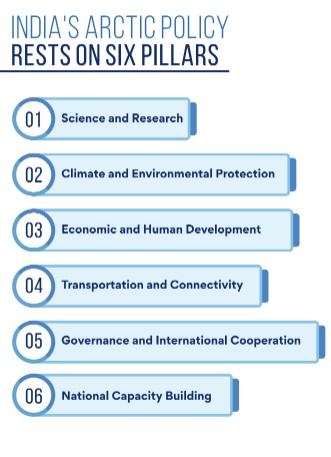CURRENT AFFAIRS
Get the most updated and recent current affair content on Padhaikaro.com
India’s arctic Policy
- Vaid's ICS, Lucknow
- 21, Mar 2022

Why in News?
- The National Land Monetisation Corporation (NLMC) is being set up with the Recently, the Ministry of Earth Science has unveiled India’s Arctic Policy, titled ‘India and the Arctic: building a partnership for sustainable development’.
Major Highlights of the policy
India’s Arctic policy titled ‘India and the Arctic: building a partnership for sustainable development’ lays down six pillars:
- Strengthening India’s scientific research and cooperation
- Climate and environmental protection
- Economic and human development
- Transportation and connectivity
- Governance and international cooperation
- National capacity building in the Arctic region.
- India’s Arctic policy shall be implemented through an action plan, and aeffective governance and review mechanism involving the inter?ministerial Empowered Arctic Policy Group.
- Implementing India’s Arctic policy will involve multiple stakeholders, including academia, the research community, business, and industry.

India And The Arctic – A History Of Cooperation
- India’s engagement with the Arctic started in February 1920, when it signed the Svalbard Treaty in Paris.
- India has ratified almost all international treaties and is a member of international organisations that are relevant to the Arctic.
Expeditions:
- India launched its first scientific expedition to the Arctic in 2007 to initiate a series of baseline measurements in biological sciences, ocean and atmospheric sciences and glaciology.
- Subsequently, the Indian research station Himadri at the international Arctic research base at Ny-Ålesund in Spitsbergen, Svalbard was dedicated to the nation in 2008.
- In 2016, India’s northernmost atmospheric laboratory was established at Gruvebadet.
Other involvements
- Indian researchers are also monitoring arctic glaciers for their mass balance and comparing them with glaciers in the Himalayan region.
- India has also been actively involved in studies related to the Arctic oceanography, atmosphere, pollution and microbiology.
- Since becoming an Observer nation in the Arctic Council in 2013, India has been actively participating in meetings of Senior Arctic Officials and contributing to the six Working Groups of the Arctic Council.
- India’s engagement with the Arctic region has been consistent and multidimensional. The country maintains that all human activity should be sustainable, responsible, transparent, and based on respect for international laws.
Benefits /Opportunities:
- India’s interests in the Arctic are scientific, environmental, economic as well as strategic.
- It is for this reason that India’s engagement with the Arctic region over the decades has been consistent and multi-dimensional.
- India believes that any human activity in the fragile region should be sustainable, responsible and transparent, based on respect for international laws, including UNCLOS.
- Melting Arctic ice also opens up new opportunities like energy exploration, mining, food security, and shipping.
- India is the third-largest energy-consuming country in the world, the third-largest oil importer (83 per cent) and the fourth-largest importer of gas which caters to almost half of the total gas consumption.
- India’s gas mix in the energy basket amounts to only 6 per cent, which is among the lowest in the world, compared to the world average of 24 per cent.
- This is targeted to be scaled up to 15 per cent by 2030.
- The Arctic can therefore potentially address India’s energy security needs and deficiency of strategic and rare earth minerals.
Challenges:
- The vulnerability of the Arctic to unprecedented changes in the climate is manifested by the loss of sea ice, ice caps, and warming of the ocean and atmosphere.
- It will lead to lowering of salinity levels, rising temperature differential between land and oceans in the tropical regions, drying of subtropical areas and increase in precipitation at higher latitudes.
- India is particularly impacted due to the likely effect of these changes on critical aspects of national development such as economic security, water security and sustainability, weather conditions and monsoon patterns, coastal erosion and glacial melting.
- The Covid-19 pandemic has exposed the scale of disruption that can be caused by pathogens. The thawing of permafrost soil as a result of global warming could also potentially release viruses and bacteria that have been dormant for thousands of years, thereby increasing the probability of pandemics.
Facts for Prelims :
About:
CYCLONE ASANI
People living in coastal areas of Andaman and Nicobar Islands were evacuated to safety as the archipelago experienced heavy rain and strong winds due to Cyclone Asani on Sunday
- The depression over the southeast Bay of Bengal intensified first into a deep depression and later into a cyclonic storm.
- Shipping services between the islands and those connecting Chennai and Visakhapatnam have been stopped and fishermen have been warned not to venture into the sea as the year’s first cyclonic storm neared the archipelago.
- A total of 68 National Disaster Response Force (NDRF) personnel have been deployed in Port Blair, and 25 each in Diglipur, Rangat and Hutbay areas.
- The system is expected to move towards the Bangladesh-Myanmar coasts.